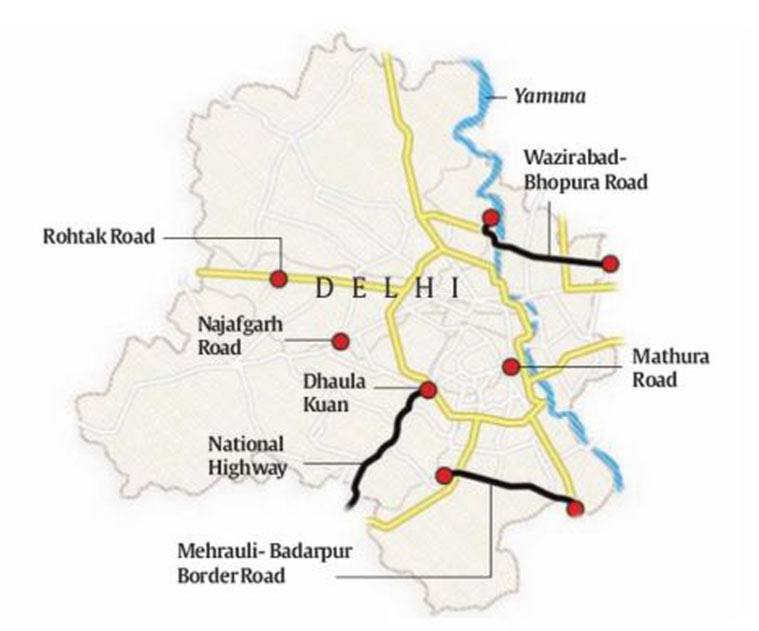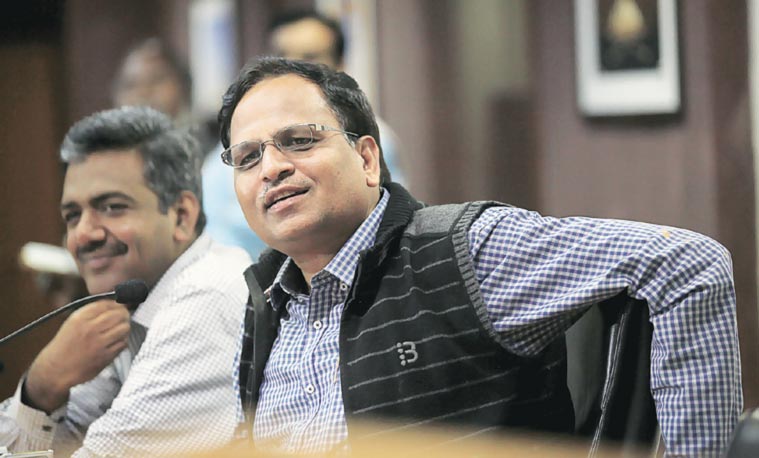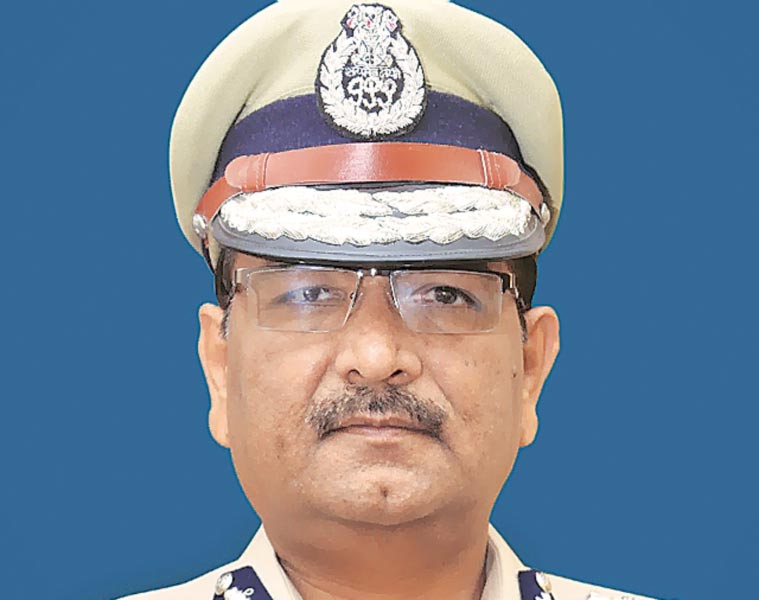The Indian Express reporters give the lowdown on the messy state of affairs, after criss-crossing badly affected road stretches across the city and speaking to key officials
Mehrauli-Badarpur road
Traffic moved at a snail’s pace. Worse still, the ride at noon was agonisingly rattling. Here is the first-hand experience of a pain point on MB Road, the stretch from near Tughlakabad Fort to Sangam Vihar. The road was cratered for more than 100 metres, from near the BSF headquarters up to Hamdard Nagar.
Sangam Vihar traffic circle officer said the Public Works Department (PWD) had levelled two large potholes recently after complaints, but the smaller ones had not been touched yet. With no drainage to clear the runoffs, monsoon wreaked havoc in Sangam Vihar and Vayusenabad areas this year. The roads suffered the most. PWD officials said the roads would be relaid properly only after the tendering process was over.
* The MB Road is almost 12-km long with a right-of-way transportation of 45m and 6-lane divided carriageway. The road, whose upkeep was transferred from MCD to PWD in April 2004, connects NH-2 at Badarpur to Aurobindo Marg close to Qutub Minar in Southeast Delhi.
 MB Road: Rundown state of the road near BSF headquarters . (Express Photo by Ravi Kanojia)
MB Road: Rundown state of the road near BSF headquarters . (Express Photo by Ravi Kanojia)
The area which sees the Loni flyover cross over to Uttar Pradesh from Delhi sees heavy domestic vehicular traffic. Big craters on the Wazirabad bridge and the four-way crossing at the mouth of the Loni flyover have been left to their state for the last six months or more, say traffic police.
As a temporary solution, we ask labourers or trucks to stop by and offload construction material or sand which they transport via these roads. But then, ongoing traffic, wind and rain blow and wash away the material in a matter of days,” Seemapuri traffic circle officer Sunil Kumar said. “I have complained to the PWD, in writing as well as in person, but they never turn up to solve the problem. Improving the condition of roads is something we are not equipped to do, though we do the best we can.”
* The Wazirabad-Bhopura border road running through North and East Delhi is a thoroughfare which has large swathes of road area eroded, leaving the four-way intersection at the foot of the Loni flyover in a decrepit mess.

Rohtak Road and Najafgarh interior road
The Rohtak road, under the railway line, almost resembles a dirt road, where vehicles trudge through at speeds as low as 5kmph and even less. The road then leads up to Najafgarh interior road, where construction work for the Najafgarh Metro station takes up the left half of the road, leaving the other half to bear two-way traffic.
A few days ago, Metro workers were seen managing traffic at the T-Point, with traffic almost at a standstill because of merging lanes and streams of vehicles on either side of the road waiting for each other to give way.
Traffic police officials said the roads were worse earlier, but recently laid afresh by the PWD. However, a stretch of around 200 metres had deep abrasions. “The roads are not bad here but in parts they are terrible. There is a reason people joke Najafgarh is Jam-garh,” a traffic official said.
* The Rohtak Road and Najafgarh interior road, which runs into Najafgarh village and joins the main road to Chhawla and Bahadurgarh in Haryana, are in poor state.
Mathura Road
The coal tar on the 100-metre stretch of main road below the Sarita Vihar Metro station in Southeast Delhi and the service lane running parallel is heavily eroded. With commercial and domestic vehicles plying during the day, and heavy vehicles at night, the traffic at peak hours is painfully heavy and difficult to manage, say traffic police.
”We receive several PCR calls from irate people complaining about the traffic, but what are we supposed to do? The road and the service lane are so damaged after the rains that traffic comes to a near halt while crossing the stretch. And we take hours to clear the passage of the two-way traffic,” a traffic police officer said. “We have been complaining to the PWD but they said they will lay the coal tar on the potholed patches only after the monsoon is over. They have been doing some work in the last few days on this stretch.”
* Mathura road, the thoroughfare which connects Delhi and Mathura has some of the worst road conditions in the city.
National Highway 8
The national highway 8, while passing by the Dhaula Kuan Metro station on the Airport Expressway, sees several potholes. “And this is the route that the Prime Minister takes while shuttling in and out of the city,” 26-year-old Rohan, who was travelling in an auto, said. Traffic police said the road had been in such a state for the last few months, with the monsoon worsening the condition. “Deep craters and potholes on this 200-metre stretch are a hazard. Two-wheelers are the most vulnerable to accidents. Small cars also suffer,” said a traffic police officer.
“The road structure also worsens the situation,” he added, pointing to a curve on the main road. “This curve was designed for a bus stop, which two months ago was shifted to the spot under the Metro station. This lane lies unused, resulting in wastage of precious road space. And it is us who have to take the wrath of the commuters. Why don’t they call up the PWD? Why do they dial 100 when it is not a problem of our making?”
* Potholes dot national highway 8 stretch which passes by Dhaula Kuan Metro station on the Airport Expressway.
State of roads apart, 10 Most congested points (Source: Traffic police)
* IIT Flyover to Panchsheel Marg
* R R Ashram
* Ashram Chowk to Maharani Bagh
* Khanpur T-point
* ISBT Kashmere Gate
* Mukarba Chowk
* Uttam Nagar Chowk
* Peeragarhi Chowk
* Kamal T-Point
* G T Road Shastri Park
Why have traffic cops gone into hibernation? asks PWD minister
Delhi Public Works department (PWD) minister Satyendar Jain, an architect, plans to redesign the entire 1,260-km stretch of roads in Delhi to make them commuter-friendly. He tells Mayura Janwalkar traffic police cannot wash its hands of responsibility of traffic management by blaming PWD.
 PWD minister Satyendar Jain
PWD minister Satyendar Jain
Traffic police have often tweeted about traffic congestion due to potholes and claimed to have informed the PWD about the poor condition of roads. How do you read the situation?
Traffic police officers have knowingly withdrawn from the streets of Delhi. Their visibility is almost zero. They have not been issuing challans to offenders because the money collected through challans goes to Delhi government. Traffic management is their job, if they are unable to do it, they can hand it over to us. Before the Assembly elections, traffic police were very active. Why have they gone into a state of hibernation now? They have instructions from the top. Political interests are deliberately leading to such situations so that it reflects poorly on the Delhi government. For instance, some roads that have potholes are maintained by Municipal Corporation of Delhi. However, it is projected as though the government has failed to maintain them.
How are commuters’ woes over increasing potholes being handled?
When we get a complaint about a pothole, we try to resolve it within 48 hours. A dry spell is required to fill potholes caused during the monsoon. Since the weather is suitable now, potholes that have not been filled will be repaired by September 30.
Delhi’s roads are due for carpeting. When is the process likely to start?
We will start the work soon. We have decided to use milling technology. Instead of adding new layers and a 100 mm top layer to the road, only 40 mm will be laid after removing the old surface. This will not increase the road’s height. We have set a target of six months to complete the process at an estimated cost of Rs 500-600 crore. Of Delhi’s 1,260-km road length, about 600 km needs complete overhaul, about 300-400 km needs carpeting and about 300 km needs no work.
How will redesigning Delhi’s roads help decrease traffic congestion?
Delhi’s roads are wide, but not safe or good for traffic movement. We have two-lane, three-lane and four-lane roads, but their capacity keeps fluctuating. Sometimes a four-lane road may work like a three-lane road. There might be easier traffic flow in three lanes than in four. Some people think if we make a 10-lane road, there will be no traffic snarls; that is not the case. There are technicalities. We have built flyovers to cut through traffic but because of designing flaws, there is congestion at the bottom. Roads are designed by giving preference to private cars. There are no provisions for public transport, pedestrians or cyclists. A holistic approach will be taken while redesigning Delhi’s roads.
What redesigning ideas is the government considering?
One of the ideas is to change the concept of ‘last-mile connectivity’ to ‘half-mile connectivity’. We plan to clear about 800m around Metro stations of all kinds of traffic. This half-mile around the station will have safe, well-lit footpaths. Commuters will not need any kind of transport for half-a-mile. Feeder bus routes too will be redesigned. We have had talks with the Delhi Metro Rail Corporation about increasing the capacity of coaches. At present, we have about 25-26 lakh cars on Delhi’s roads. In five years, this figure may multiply one-and-a-half or two times. How that kind of traffic will be handled is beyond comprehension.
Need permanent solutions, says city’s top traffic officer
Special Commissioner of Police (Traffic) Muktesh Chander tells Sarah Hafeez why bad roads compound traffic problems, how European countries deal with potholes and where our authorities err.
 Special Commissioner of Police (Traffic) Muktesh Chander
Special Commissioner of Police (Traffic) Muktesh Chander
What are the problems traffic police encounter due to potholed and decrepit roads?
There is a direct correlation between bad roads and traffic problems. Potholed and cratered roads reduce speed of vehicles considerably and there is little space or opportunity for negotiating one’s vehicle. This leads to slowing down of traffic and consequent congestion. Traffic management becomes tricky in such situations and traffic police can do nothing because it is a problem of road quality.
Since when have the roads deteriorated?
There is no noted date, but the condition of roads usually worsens around summers and monsoons. This monsoon, particularly, ruined the condition of roads. Moreover, repair work on potholes and craters is also many a times faulty. Either the filling is insufficiently applied to the caved-in portion or there is excess filling, leading to a bump on the road. In European countries, I saw authorities do not fill potholes. They use machines to cut out a neat quadrangle around the pothole and apply material evenly to the portion. The result is a level road with just a patch of different colour topping material.
What does traffic police do to solve these problems?
Traffic police, primarily, inform the PWD and keep them updated on such problems. Also, to temporarily solve the pothole issue, traffic police use concrete, sand, mud or other such material. We need permanent solutions. This said, potholes are not the only or primary cause of traffic jams and congestion in the city. Faulty and unscientific road design, road curvatures, trees or road signages blocking road and other varied reasons lead to traffic snarls and bottlenecks.










